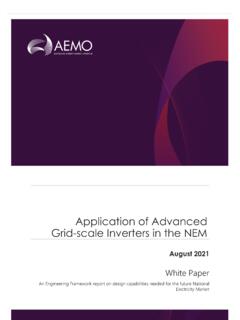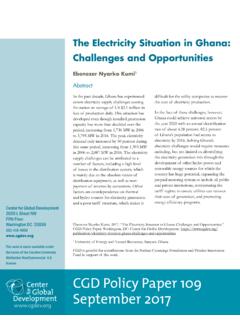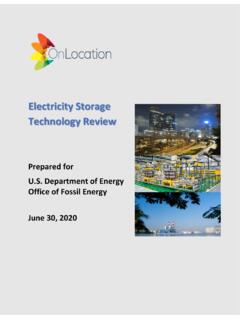Transcription of The National Electricity Market - AEMO
1 fact SheetThe NationalElectricity MarketNEM fast factsThe NEM commenced operation as a wholesale spot Market for Electricity in December NEM incorporates around 40,000 km of transmission lines and NEM supplies about 200 terawatt hours of Electricity to businesses and households each year.$ billion was traded in the NEM in NEM supplies approximately nine million NEM has a total Electricity generating capacity, including Rooftop solar PV, of almost 54,421 MW (as at December 2017).Strategic reserves of demand and generation resources of more than 1000 MW for National Electricity Market (NEM) operates on one of the world s longest interconnected power systems, stretching from Port Douglas in Queensland to Port Lincoln in South Australia and across the Bass Strait to Tasmania a distance of around 5,000 NEM spans Australia s eastern and south-eastern coasts and comprises five interconnected states that also act as price regions: Queensland, New South Wales (including the Australian Capital Territory), South Australia, Victoria, and Australia and the Northern Territory are not connected to the NEM, primarily due to the distance between NEM s transmission network carries power from Electricity generators to large industrial energy users and local Electricity distributors across the five states.
2 These assets are owned and operated by state governments, or private are over 300 registered participants in the NEM, including Market generators, transmission network service providers, distribution network service providers, and Market customers. THE National Electricity Market The National Electricity Market (NEM) operates on one of the world s longest interconnected power systems, stretching from Port Douglas in Queensland to Port Lincoln in South Australia and across the Bass Strait to Tasmania a distance of around 5,000 kilometres. The NEM spans Australia s eastern and south-eastern coasts and comprises ve interconnected states that also act as price regi ons: Queensland, New South Wales (including the Australian Capi tal Territory), South Australia, Victoria, and Tasmania. Western Australia and the Northern Territory are not connected to the NEM, primarily due to the distance between networks. The NEM s transmission network carries power from Electricity generators to large industrial energy users and local Electricity distributors across the ve states.
3 These assets are owned and operated by state governments, or private businesses. There are over 200 regi stered participants in the NEM, including Market generators, transmission network service providers, distribution network service providers, and Market customers. MELBOURNESYDNEYBRISBANEADELAIDEHOBA RT NEM FAST FACTSThe NEM commenced operation as a wholesale spot Market for Electricity in December 1998. The NEM incorporates around 40,000 km of transmission lines and cables. The NEM supplies about 200 terawatt hours of Electricity to businesses and households each year. $ billion was traded in the NEM in FY2016-17. The NEM supplies approximately nine million customers. The NEM has a total Electricity generating capacity of almost 52,500 MW (as of April 2017). fact SheetThe NationalElectricity MarketFact SheetThe Electricity networkTo understand the NEM, it s necessary to understand the journey that Electricity takes as it travels from generators to customers, and the technology and infrastructure that makes this possible.
4 When an electrical appliance is switched on, power is instantly transmitted from a power station to the appliance. Although this occurs instantaneously, a specific sequence of events takes place to ensure the required Electricity is delivered, as illustrated below:The spot marketThe NEM is a wholesale commodity exchange for Electricity across the five interconnected states. Electricity cannot be stored easily, so the Electricity Market works as a pool , or spot Market , where power supply and demand is matched instantaneously in real time through a centrally coordinated dispatch offer to supply the Market with specified amounts of Electricity at specified prices for set time periods, and can re-submit the offered amounts at any all the bids offered, the Australian Energy Market Operator (AEMO) decides which generators will be deployed to produce Electricity , with the cheapest generator put into operation first. NEM operation is designed to meet Electricity demand (or consumption) in the most cost-efficient NationalElectricity MarketTransport of electricity1 GENERATORP roduces low voltage Electricity to high voltage for efficient LINESC arry Electricity long high voltageelectricity to low voltage for LINESC arry low voltage Electricity to , OFFICES AND FACTORIES Use Electricity for lighting and heating and to power SOLAR PV AND BATTERIESCan provide energy back into the and selling Electricity THE National Electricity Market THE Electricity NETWORKTo understand the NEM, it s necessary to understand the jo urney that Electricity takes as it travels from generators to customers, and the technology and infrastructure that makes this possible.
5 When an electrical appliance is switched on, power is instantly transmitted from a power station to the appliance. Although this occurs instantaneously, a specific sequence of events takes pl ace to ensure the requi red Electricity is delivered, as illustrated below: BUYING AND SELLING Electricity THE SPOT MARKETThe NEM is a wholesale commodity exchange for Electricity across the five interconnected states. Electricity cannot be stored easily, so the Electricity Market works as a matched instantaneously in real time through a centrally coordinated dispatch process. Generators offer to supply the Market with specified amounts of Electricity at specified prices for set time periods, and can re-submit the offered amounts at any time. From all the bids offered, the Australian Energy Market Operator (AEMO) decides which generators will be deployed to produce Electricity , with the cheapest generator put into operation first. NEM operation is designed to meet Electricity demand (or consumption) in the most cost-efficient way.
6 ENERGY RESOURCE SElectricity is produced by converting the energy found in resources, such as black or brown coal, natural gas, or oil. Renewable energy sources like solar and wind are also being used to produce Electricity . ANNUAL GENERATION BY FUEL TYPE (2015/16): 100%197,723 GWh 77%152,463 GWh 9%18,324 GWh 7%14,487 GWh 5%10,379 GWh 1%2,070 GWh Data does not include generation from rooftop solar PV systems GASWATERWINDOTHERTRANSPORT OF ELECTRICITYGENERATORP roduces ElectricityDISTRIBUTIONTRANSFORM ERConverts high voltageelectricity to low voltage LINESC arry low voltageelectricity to , officesand factories useelectricity for lightingand heating and topower ERConverts low voltageelectricity to high voltagefor efficient ISSIONLINESC arry Electricity resourcesElectricity is produced by converting the energy found in resources, such as black or brown coal, natural gas, or oil. Renewable energy sources like solar and wind are also being used to produce generation by fuel type (2016/17):100% TWh77% TWh 9% TWh 8% TWh 5% TWh TWh TWh Data does not include generation from rooftop solar PV systems.
7 THE National Electricity Market THE Electricity NETWORKTo understand the NEM, it s necessary to understand the jo urney that Electricity takes as it travels from generators to customers, and the technology and infrastructure that makes this possible. When an electrical appliance is switched on, power is instantly transmitted from a power station to the appliance. Although this occurs instantaneously, a specific sequence of events takes pl ace to ensure the requi red Electricity is delivered, as illustrated below: BUYING AND SELLING Electricity THE SPOT MARKETThe NEM is a wholesale commodity exchange for Electricity across the five interconnected states. Electricity cannot be stored easily, so the Electricity Market works as a pool , or spot Market , where power suppl y and demand is matched instantaneously in real time through a centrally coordinated dispatch process. Generators offer to supply the Market with specified amounts of Electricity at specified prices for set time periods, and can re-submit the offered amounts at any time.
8 From all the bids offered, the Australian Energy Market Operator (AEMO) decides which generators will be deployed to produce Electricity , with the cheapest generator put into operation first. NEM operation is designed to meet Electricity demand (or consumption) in the most cost-efficient way. GASCOALWATERWINDSOLARTRANSPORT OF ELECTRICITYGENERATORP roduces ElectricityDISTRIBUTIONTRANSFORM ERConverts high voltageelectricity to low voltage LINESC arry low voltageelectricity to , officesand factories useelectricity for lightingand heating and topower ERConverts low voltageelectricity to high voltagefor efficient ISSIONLINESC arry Electricity SheetThe NationalElectricity MarketElectricity production is matched to Electricity consumption, and spare generating capacity is always kept in reserve in case it s needed. The current energy price then can be calculated. Electricity production is also subject to transmission limitations so that the network is not delivering Electricity , a dispatch price is determined every five minutes, and six dispatch prices are averaged every half-hour to determine the spot price for each NEM region.
9 AEMO uses the spot price as its basis for settling the financial transactions for all Electricity traded in the National Electricity Rules (the Rules) set a maximum spot price, also known as the Market Price Cap. On July 2017, this cap was set at $14,200 per megawatt hour, and is adjusted annually for inflation. The Rules also set a minimum spot price, called the Market floor price. The Market floor price is -$1,000 per megawatt hour. The Australian Energy Market Commission s Reliability Panel reviews the Market price cap and Market floor price settings every four years to ensure they align with the NEM reliability pay generators, AEMO must recover costs from customers. Most customers don t participate directly in the NEM, so they purchase their Electricity through a retailer. Customers pay the retailers a commercial tariff, and retailers manage customers energy purchases, including paying AEMO the spot participants need to manage the financial risks associated with the significant spot price volatility that occurs during trading periods.
10 They achieve this by using financial contracts that lock in a firm price for Electricity that will be produced or consumed at a given time in the future. These arrangements are generally in the form of derivatives, and include swaps or hedges, options and futures SheetThe NationalElectricity MarketHow the NEM worksThe NEM is a wholesale Electricity Market in which generators sell Electricity and retailers buy it to on-sell to consumers. There are over 100 generators and retailers participating in the Market , so it s highly competitive and therefore an efficient way of maintaining relatively competitive Electricity prices in the wholesale Market . THE National Electricity Market Electricity production is matched to Electricity consumption, and spare generating capacity is always kept in reserve in case it s needed. The current energy price then can be calculated. Electricity production is also subje ct to transmission limitations so that the network is not overloaded.





